
.jpg)
Switchback Travel

.jpg)
Switchback Travel
An ideal travel camera is lightweight, versatile, and captures great images. Point-and-shoots are the smallest and least expensive option, but they have some limitations in terms of image quality. Mirrorless interchangeable-lens cameras have big sensors and are more compact than digital SLRs—any traveler should give serious consideration to going in this direction. Digital SLRs are the bulkiest and heaviest option but capture professional-grade photographs and offer the widest selection of lenses. Below are our picks for the best travel cameras of 2019 broken down into three categories: point-and-shoots, mirrorless cameras, and digital SLRs. For more information, see our travel camera comparison table and buying advice after the picks.
The only truly pocketable camera for travel is a point-and-shoot (mirrorless interchangeable-lens cameras have a noticeably bigger profile). Point-and-shoots have come a long way in recent years, now offering large image sensors, fast lenses, and popular features like built-in image stabilization and Wi-Fi. They also are the lightest in weight and the lowest liability should something happen on the road.
 Weight: 11.3 oz.
Weight: 11.3 oz.
Sensor size: 116 sq. mm
Megapixels: 20.1
Zoom: 24-100mm
What we like: Large image sensor and fast lens.
What we don’t: Less zoom than the Panasonic ZS200 below.
Sony led the premium point-and-shoot charge for years, but Canon has come on strong of late and the G7 X Mark II is case in point. This popular camera is a great option for travelers with a large 1” sensor, 24-100mm of zoom, ample features including touchscreen functionality and built-in Wi-Fi, and a compact form factor that easily fits in your pocket. And we love the lens in particular, which has a fast maximum aperture of f/1.8-2.8, which is considerably better in low light than any other point-and-shoot on this list, including the pricey Sony RX100 VII below.
In comparing the G7 X Mark II to a competing camera like the Panasonic ZS200 below, the Canon is slightly cheaper and wins out in terms of low-light performance and bokeh, but the Panasonic has more zoom at 24-360mm and therefore is more versatile. If you don’t need the zoom range, the G7 X Mark II has a better lens and offers superior image and video quality overall. And for those looking to save, the trimmed-down Canon G9 X Mark II has the same image sensor, weighs just 7.4 ounces, and is a solid value at just over $400, but you get less zoom at 28-84mm and a slower lens.
See the Canon G7 X Mark II
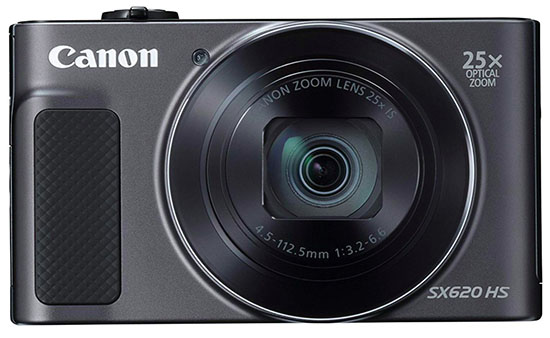 Weight: 6.4 oz.
Weight: 6.4 oz.
Sensor size: 28 sq. mm
Megapixels: 20.2
Zoom: 25-625mm
What we like: Serious zoom at a low price and weight.
What we don’t: Small image sensor.
If you are in the market for big-time zoom at a reasonable price point, the Canon SX620 is a nice all-around camera from one of the best brands in the business. This sleek point-and-shoot checks a lot of boxes for travelers: it’s lightweight and easily pocketable at just 6.4 ounces, offers an impressive optical zoom range of 25-625mm, and comes with built-in Wi-Fi. Perhaps most importantly, the price tag is much more approachable than the premium models on this list like the Canon G7 X Mark II above. In terms of versatility and bang for your buck, the Canon SX620 HS is tough to beat.
The most notable weakness of the Canon SX620 HS is its small 1/2.3" image sensor. This is very common on cameras in this price range and certainly not a deal-breaker, but it does mean that there are real limitations in image quality, and especially if you plan on making large prints. In addition, the lens has a maximum aperture of f/3.3-6.9, which isn’t as good in low light as the more expensive options on this list (the Canon G7 X Mark II has an f/1.8-2.8 lens, for example). And for a similar camera with more features, the newer Canon SX730 HS has even more zoom at 24-960mm but costs $379.
See the Canon SX620 HS
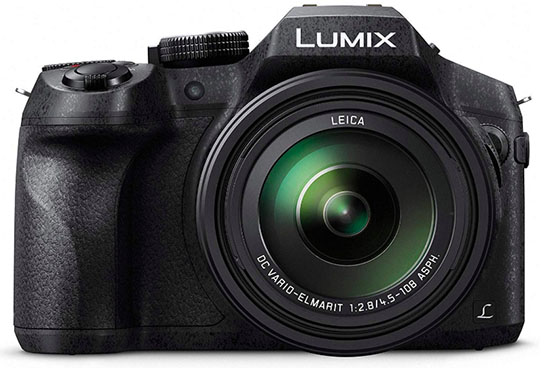 Weight: 24.4 oz.
Weight: 24.4 oz.
Sensor size: 116 sq. mm
Megapixels: 12.1
Zoom: 25-600mm
What we like: Big zoom and a quality lens for around $400.
What we don’t: Bulky and heavy.
For the versatility of a digital SLR without the hassle of carrying around and changing out multiple lenses, a healthy number of travelers decide to go the superzoom route. In this category, one of the best values of 2019 is the Panasonic FZ300, which offers 25-600mm of zoom along with an impressive f/2.8 lens. You even get modern features like 4K video and built-in Wi-Fi, all for less than $400. It’s true that superzooms are very bulky and heavy—they weigh as much or more than some DSLRs—but the convenience and image quality are unparalleled.
The Panasonic FZ300 is one of the cheaper superzooms on the market, and you certainly can step it up in quality. For example, the Panasonic FZ1000 has a larger 1” image sensor (the FZ300 is 1/2.3"), more megapixels, faster shooting speeds, and slightly less zoom at 25-400mm, but the price goes up to $598. And for those with deep pockets, Sony’s RX10 series leads the category with large sensors, fast lenses, and a full range of advanced features and functionality, but the latest RX10 IV model is a whopping $1,600. All are fine options depending on your budget, but we appreciate the value of the FZ300 here.
See the Panasonic FZ300
 Weight: 10.7 oz.
Weight: 10.7 oz.
Sensor size: 116 sq. mm
Megapixels: 20.1
Zoom: 24-200mm
What we like: Pretty much the whole package in a point-and-shoot.
What we don’t: Super expensive and the lens isn’t particularly fast at f/2.8-4.5.
Sony’s RX100 line of premium point-and-shoots is borderline legendary, and the new VII is the latest and greatest model. This compact camera has just about every feature you can ask for: a large 1” image sensor, a Carl Zeiss lens with 24-200mm of range, advanced autofocus that is light years ahead of entry-level point-and-shoots, 4K video, and just about all the other bells and whistles available in 2019. And at 10.7 ounces, it’s the ultimate travel camera for those who want a lighter alternative to their interchangeable-lens set-up while making the fewest possible compromises.
The elephant in the room here is price. Nearly $1,200 is a lot to spend on a point-and-shoot, no matter how impressive the features are. You could go with a wide number of entry-level mirrorless cameras or DSLRs below for less than half that cost, and even a quality mid-range option like the mirrorless Fujifilm X-T30 below will far outperform the Sony in terms of image quality. Second, it’s worth noting that although the Zeiss lens has solid zoom and great clarity, the maximum aperture of f/2.8-4.5 isn’t all that impressive (Canon’s G7 X Mark II wins out in this regard at f/1.8-2.8). But there’s no denying the convenience or small form factor of the Sony RX100 VII—ounce for ounce, it packs as much punch as any camera on this list.
See the Sony RX100 VII
 Weight: 12 oz.
Weight: 12 oz.
Sensor size: 116 sq. mm
Megapixels: 20.2
Zoom: 24-360mm
What we like: A large sensor and great zoom.
What we don’t: The lens can’t match the Canon G7 X Mark II or Sony RX100 VII.
Among its peers, the Panasonic ZS200 stands out for its image quality and versatility. For travelers, this camera pretty much does it all: you get a large 1” image sensor, an impressive zoom range of 24-360mm, and advanced features like 4K video and touchscreen functionality. The lens is wide enough for landscapes yet can still capture those far-off details that are an important (and fun) aspect of travel photography. For comparison, the Canon G7 X Mark II above has a much more limited zoom range at 24-100mm.
What are the shortcomings of the Panasonic ZS200? First and foremost, the lens has a maximum aperture of f/3.3-6.4, meaning that the camera isn’t particularly strong in low light and you’ll have trouble getting the bokeh (blurry background) that professionals love. Second, Panasonic cameras often are impressive on paper, but brands like Canon and Sony tend to win out in real-world ease of use and functionality. That said, you’ll be hard-pressed to match the do-everything nature of the ZS200, which is why we have included it here.
See the Panasonic Lumix ZS200
 Weight: 7.8 oz.
Weight: 7.8 oz.
Sensor size: 328 sq. mm
Megapixels: 16.2
Zoom: 28mm prime lens (no zoom)
What we like: Extra-large APS-C image sensor.
What we don’t: The fixed 28mm lens isn’t for everyone.
The Ricoh GR II is unassuming but should not be overlooked by travelers, and it’s one of the top point-and-shoots on the market for street photography. First and foremost, you get an APS-C image sensor, which is the same as many DSLRs and mirrorless cameras and roughly three times the size of the more highly touted Canon and Sony point-and-shoots above. All of this image quality comes in at just 7.8 ounces total, which is extremely impressive. And the price isn’t bad either: the Ricoh GR II is cheaper than the Canon G7 X Mark II, Panasonic ZS200, and Sony RX100 VII (by a long shot).
The biggest tradeoff here is the fixed lens, which is set at 28mm and means that you get no zoom whatsoever. This concept is a bit polarizing: 28mm happens to be a great focal length for walking around major cities while traveling. And as the saying goes, “If you need more zoom, just take a few steps forward.” At the same time, we prefer to go wider for landscapes and you certainly won’t be zooming in for macro or wildlife photography with this camera. But very few travelers have an image sensor like this in their pockets, which is why the Ricoh has a dedicated following among professionals.
See the Ricoh GR II
Mirrorless interchangeable-lens cameras represent the latest wave in camera technology. Sleek and modern, they forego the bulky internal mirror systems of DSLRs (hence the name), and as a result, are lighter and more compact. In our opinion, mirrorless is the best type of camera for travel, offering outstanding image quality (much better than a point-and-shoot) with less bulk and weight than a DSLR.
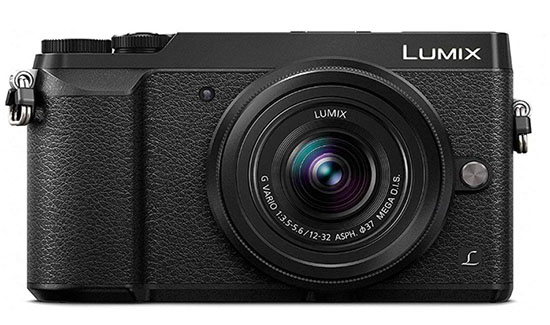 Weight: 15 oz.
Weight: 15 oz.
Sensor size: 225 sq. mm
Megapixels: 16
What we like: A tremendous value for a mirrorless camera with two lenses.
What we don't: Low on megapixels.
If you’re looking for a good value in the mirrorless world, the Panasonic Lumix GX85 is exactly that. For around $600, you get a camera with a Micro Four Thirds image sensor and a host of modern features including in-body image stabilization, 4K video, shooting speeds of up to 10 frames per second, and built-in Wi-Fi. Perhaps most impressively, the GX85 kit includes two lenses: a 12-32mm and 45-150mm, giving you a nice range of focal length coverage from wide angle to telephoto. We especially like the low-profile size of the 12-32mm, which weighs just 2.5 ounces and is a great walk-around lens for travel and everyday use.
It's worth noting that mirrorless cameras run the gamut from entry-level (like the Panasonic GX85 and Canon M50 below) to full-frame (the Canon EOS RP and Sony a7R III below). The choice often comes down to how much you want to spend, and those full-frame models certainly do impress with their image and video quality and array of features. But the Panasonic GX85 is nothing to scoff at, and at just 15 ounces, is easy to carry and fairly discreet. For those looking to step up their game from a point-and-shoot and get much better resolution in the process, it’s a great option.
See the Panasonic Lumix GX85
 Weight: 13.6 oz.
Weight: 13.6 oz.
Sensor size: 332 sq. mm
Megapixels: 24.1
What we like: Better resolution than the Panasonic GX85, and lighter too.
What we don't: More expensive than the GX85 with only one lens included.
Canon was relatively late to the mirrorless game, but the camera behemoth is coming on strong. And because many people already are familiar with Canon DSLRs and point-and-shoots, the mirrorless M50 is a popular option. For around $650, you get an APS-C image sensor, which is larger than the Micro Four Thirds sensor on the Panasonic above, along with 24.1 megapixels of resolution. Given that this is the second generation of Canon mirrorless, the feature set has been honed-in including 4K video, fast and accurate autofocus, and a touchscreen LCD, which has a nice "Touch and Drag AF" feature that is great for making quick adjustments on the fly. Keep in mind that the M50 uses E-FM (mirrorless) lenses, but Canon does make an in-house adapter for your EF and EF‐S glass.
In comparing the Canon M50 with the Panasonic GX85 above, the Canon wins out in resolution (both in sensor size and megapixels), plus it’s slightly lighter in weight. On the flip side, the Panasonic comes with two lenses, has a longer battery life, and in-camera image stabilization (this helps with hand-held photos in low light and while on the go). Both are leading budget options in the mirrorless category, and the choice often comes down to which system and lens type you want to buy into. And of course, those with existing Canon DSLR lenses likely will give the M50 a leg up.
See the Canon M50
 Weight: 17.1 oz.
Weight: 17.1 oz.
Sensor size: 861 sq. mm
Megapixels: 26.2
What we like: The lightest full-frame camera on the market and a great value.
What we don’t: Does not excel at action or video.
Shifting gears to the enthusiast end of the mirrorless spectrum, Canon is leading the charge in lightweight full-frame cameras. The new EOS RP was released in 2019 and weighs in at just 17.1 ounces for the camera body, which is particularly impressive given its massive image sensor. For travelers seeking big-time image quality, the compact size and low weight are crucial, the 26.2 megapixels are likely all that you’ll need, and Canon’s RF lens selection is reaching a critical mass where an adapter is no longer mandatory. This isn’t the best mirrorless camera for action or video shooters, but it’s a great option for travelers on the go.
It’s worth noting the trimmed-down EOS RP is the sibling of the pricier and heavier EOS R. In choosing the RP, you sacrifice just over 4 megapixels of resolution, plus it has inferior autofocus, a slower burst rate at 4 frames per second, fewer frame rates for video, and a shorter battery life. All of those are important considerations, but so are the price tag and weight, which are a significant $1,000 and 3.4 ounces less than the EOS R respectively. And for the premier mirrorless system on the market, see the Sony a7R III below.
See the Canon EOS RP
 Weight: 13.5 oz.
Weight: 13.5 oz.
Sensor size: 368 sq. mm
Megapixels: 26.1
What we like: Lighter and cheaper than the popular X-T3, but with very similar image quality.
What we don’t: No weather sealing.
The mirrorless camera options are vast in 2019, and despite having a higher price point than some of the entry-level models above, we love the X-T30 for travel. Fujifilm’s image quality and color rendition are superb, the camera weighs a reasonable 13.5 ounces, and has the same 26.1-megapixel image sensor as the pricier X-T3. Last but not least, the collection of Fujifilm X-Mount lenses is terrific—arguably the best glass of any crop sensor mirrorless system—including the very respectable 18-55mm f/2.8-4 offered in this kit. All in all, the X-T30 is more mid-range than entry-level, and you get what you pay for here.
What are the shortcomings of the Fujifilm X-T30? Unlike the pricier X-T3, it’s not weather-sealed, which can be a big factor for outdoor photographers in particular. And although Fujifilm video quality is improving, over the past few years it has lagged behind other mirrorless camera manufacturers like Panasonic and Sony. These issues aside, the X-T30 is compact, produces great images, and comes with an outstanding kit lens, making it a winner in our book.
See the Fujifilm X-T30
 Weight: 12.2 oz.
Weight: 12.2 oz.
Sensor size: 366 sq. mm
Megapixels: 24.3
What we like: A tremendous value.
What we don’t: Isn’t weather-resistant and lacks 4K video.
It’s true that the Sony a6000 is a few years old and counting, but we love the value at around $550 with a kit lens—it’s the cheapest mirrorless camera on this list. Most importantly, you get a 24.3-megapixel APS-C image sensor, fast shooting at up to 11 frames per second, built-in Wi-Fi, and a total weight of just over 12 ounces. In addition, Sony mirrorless cameras are relatively easy to use right out of the box, with a range of automatic settings (and manual settings too). For travel, it’s another compact mirrorless camera that can produce excellent images and videos.
As mentioned above, the a6000 is a past-generation model and Sony subsequently has released both the a6300 and a6500. What do you sacrifice by going with the older version? The camera lacks modern features like in-body image stabilization, weather resistance, and 4K video, all of which are relevant. But the a6500 is double the price at $1,098 for the camera body, plus the cost of lenses. If you can afford it, both the a6500 and a6300 are terrific cameras, but the a6000 is no slouch and a tremendous value while supplies last.
See the Sony Alpha a6000
 Weight: 23.2 oz.
Weight: 23.2 oz.
Sensor size: 864 sq. mm
Megapixels: 42.4
What we like: The best mirrorless camera on the market.
What we don’t: Very pricey, and so are the lenses.
For those who aren’t intimidated by the cost and weight, the Sony Alpha a7R III is the cream of the mirrorless crop. This sleek camera is the real deal: you get a full-frame image sensor with a whopping 42.4 megapixels of resolution, superb autofocus, in-body image stabilization, 4K video, weather sealing, an epic collection of lenses to choose from—we could go on and on. Importantly, the a7R III also got an upgraded battery from the older a7R II, which made a world of difference (no more carrying around all of those extra batteries on the road). For discerning travelers who want professional-grade image quality, it's the best all-around mirrorless camera on the market.
To throw a wrench in your decision, Sony just released the Sony a7R IV for fall of 2019, which offers an incredible 61 megapixels—it’s the highest-resolution full-frame camera on the market. But here’s the thing: 42.4 megapixels are ample for most people, the IV currently is on backorder at most major retailers, and the III is $1,000 cheaper. The new model does include some nice upgrades to the autofocus and undoubtedly will become the king of the hill, but the older model is less expensive and available, which is why it’s included here.
See the Sony Alpha a7R III
Traditionally, digital SLRs were considered to be the best of the best. The have large sensors, the widest selection of lenses, and feel studier in the hand than most mirrorless cameras. At the entry-level end of the spectrum, DSLRs often are cheaper than their mirrorless counterparts, and many professionals use full-frame cameras that are heavy and expensive but capture exceptional images and videos.
 Weight: 12.9 oz.
Weight: 12.9 oz.
Sensor size: 366 sq. mm
Megapixels: 24.2
What we like: A number of upgrades over the Canon Rebel T6 below.
What we don’t: Kit lens has improved but still leaves something to be desired.
Nikon has done a really nice job with its entry-level DSLR lineup, and we love the balance of price and performance of the D3500. For less than $450 with a kit lens, you get a number of upgrades over the competing Canon Rebel T6 below including more megapixels, faster shooting speeds, better ISO sensitivity for low-light photography, and a longer battery life. Of course, the camera has an APS-C image sensor, which is many times larger than most premium point-and-shoots, and Nikon functionality is known for being easy-to-use out of the box. All things considered, the D3500 is our favorite budget DSLR for travel.
It’s worth noting that Nikon offers a few tiers of camera models in the entry-level category (with some bordering on mid-range). The Nikon D5600, for example, is $150 more with the same lens but comes with an upgraded autofocus system and a tilting LCD with touch functionality. If you frequently shoot action photography or video, those features are important and the D5600 likely is worth the jump in price. But for travel photography that mostly revolves around stills, the Nikon D3500 is enough camera for most people.
See the Nikon D3500
 Weight: 17.1 oz.
Weight: 17.1 oz.
Sensor size: 332 sq. mm
Megapixels: 18
What we like: A tremendous value.
What we don’t: Stripped-down feature set.
For those who prefer Canon over Nikon or are looking to spend even less than the D3500 above, the Canon Rebel T6 is one of the cheapest DSLRs on the market from a major brand. Here’s the good news: the Rebel line is pretty much synonymous with the entry-level DSLR category, and for those who plan on shooting mostly still photography, the T6 is a terrific value. For just $400 with an 18-55mm kit lens, you get an APS-C image sensor with 18 megapixels of resolution, 1080p video, and built-in Wi-Fi. But perhaps most importantly, you get Canon’s signature easy-to-use functionality and build quality along with an extensive collection of EF-S lenses to choose from.
Considering the low price, it’s a given that the Canon Rebel T6 is a stripped-down version of some of its pricier siblings. For example, the autofocus system is fairly limited, the camera has a relatively slow burst rate at only 3 frames per second, and the rear LCD screen doesn’t have touch functionality, nor does it swivel. For more features, you can step up to the Rebel T6i ($579) or newer T7i ($799), although you are paying for a number of video-centric features. But for still shooters on a budget, the T6 is a good choice.
See the Canon Rebel T6
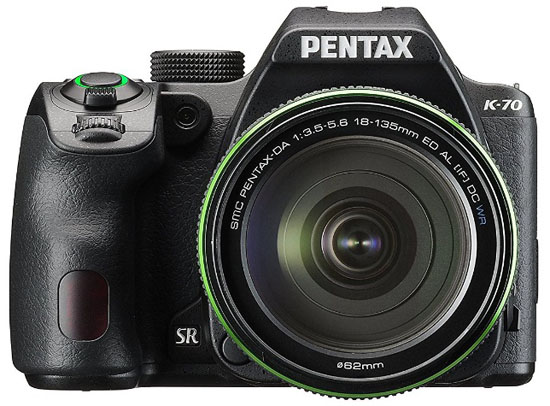 Weight: 24.3 oz.
Weight: 24.3 oz.
Sensor size: 366 sq. mm
Megapixels: 24.24
What we like: Weather-sealed.
What we don’t: Heavy and limited lens options.
Pentax doesn’t have the brand recognition of Nikon or Canon, but its DSLRs are pretty darn competitive across the board. Their biggest selling point is weather sealing: Pentax DSLRs are reinforced with extra rubber around the joints and button areas, creating a better seal around the electronics on the inside. From other brands, you’ll need to spend upwards of $1,000 or more for this feature. In addition, the K-70 is a very solid digital SLR from an image quality perspective and includes in-body image stabilization, impressive ISO sensitivity range, and customizable twin dials that allow for easy manual operation.
All in all, the Pentax is a unique digital SLR offering for travelers. The weather sealing is a big plus for those on the go, as is the in-body image stabilization. On the other hand, the lens offerings from Pentax are much more limited than Nikon or Cannon, and the weather sealing adds weight to the camera making it relatively heavy. And at around $700 with a kit lens, the K-70 is pricier than some of the options above but decidedly more mid-range in terms of features and functionality. For an even cheaper weather-sealed DSLR from Pentax, see the KS-2.
See the Pentax K-70
 Weight: 24.7 oz.
Weight: 24.7 oz.
Sensor size: 330 sq. mm
Megapixels: 32.5
What we like: The features and ergonomics can't be beat.
What we don’t: The full-frame Canon EOS RP above is only $100 more.
The DSLRs above are of the entry-level or mid-range variety, and the models below are full-frame cameras with high price tags. But some would argue that the new Canon EOS 90D is the perfect middle ground—it’s a super versatile and highly capable DSLR for enthusiasts. For around $1,200, you get an APS-C image sensor with 32.5 megapixels of resolution, a serious autofocus system that should be able to handle just about anything you can throw at it, 4K video, fast continuous shooting, and a host of other features. For all types of travel, the Canon 90D is one of the top crop-sensor DSLRs on the market in 2019.
What kind of photographers is the Canon 90D best for? Given the price of the camera, it certainly makes sense to invest in at least a couple of EF-S lenses, so the 90D fits those with an existing lens collection and who are willing to make some additional purchases. And with the quality and speed of the autofocus, it’s an attractive camera for those who like to mix in wildlife photography or video in their travels. All in all, the 90D does not have a full-frame sensor, but that’s the only real shortcoming of an otherwise terrific all-around DSLR.
See the Canon 90D
 Weight: 32.3 oz.
Weight: 32.3 oz.
Sensor size: 861 sq. mm
Megapixels: 45.7
What we like: The top DSLR on the market.
What we don’t: Bulky, heavy, and expensive.
Weight and bulk aside, the Nikon D850 is the top DSLR on the market in 2019 and a great option for travel. You get a massive full-frame image sensor with 45.7 megapixels of resolution, an ultra-advanced autofocus system, superb video quality including 4K, and just about all of the other bells and whistles you could ask for. Of course, the camera body weighs over two pounds without lenses—full-frame lenses aren’t exactly light either—but that’s the price you’ll pay for the best in image and video quality. The D850 is the DSLR that many top professionals carry in their bag and for good reason.
The biggest competitor to the D850 is the Canon 5D Mark IV below, which is an outstanding camera in its own right but falls short of the Nikon in a number of key categories. It has less resolution with a 30.4-megapixel sensor, inferior autofocus, slower buffering speeds, and shorter batter life. The 5D Mark IV does weigh slightly less and has built-in GPS, but given that both cameras are similar in price, we favor the D850 in a big way. And for a less expensive full-frame DSLR from Nikon, see the D750.
See the Nikon D850
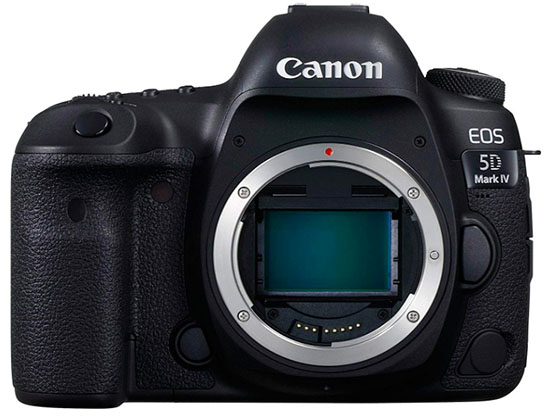 Weight: 28.2 oz.
Weight: 28.2 oz.
Sensor size: 864 sq. mm
Megapixels: 30.4
What we like: Does everything well.
What we don’t: Fewer megapixels and features than the Nikon D850 above.
Among professional cameras, many photographers pick one brand and stick with it, and the 5D Mark IV is Canon's most popular full-frame DSLR. It’s the whole package: you get 30.4 megapixels of resolution, 4K video, a burst rate of 7 frames per second for action photography, and the premium build quality and ergonomics that Canon is known for. For everyone from pro travel photographers to serious enthusiasts, the 5D is one of the top DSLRs on the market of any type.
The Canon 5D Mark IV, however, is in many ways outmatched by the Nikon D850. As described above, the Nikon wins out in most categories that matter: it has more megapixels, superior autofocus, a more modern feature set, and both cameras are similarly priced. And in an exciting new development for travel photographers, Canon is leading the charge in lightweight mirrorless cameras with its new Canon EOS RP above (17.1 ounces). For those who already own a stack of EF lenses, Canon makes an adapter for $199 and third-party options are available for less.
See the Canon 5D Mark IV
| Camera | Price | Type | Sensor | MP | Weight | Burst | Weather | 4K |
|---|---|---|---|---|---|---|---|---|
| Canon G7 X Mark II | $649 | Point-and-shoot | 116 sq. mm | 20.1 | 11.3 oz. | 8 fps | No | No |
| Canon SX620 HS | $249 | Point-and-shoot | 28 sq. mm | 20.2 | 6.4 oz. | 7.1 fps | No | No |
| Panasonic FZ300 | $398 | Point-and-shoot | 116 sq. mm | 12.1 | 24.4 oz. | 12 fps | Yes | Yes |
| Sony RX100 VII | $1,198 | Point-and-shoot | 116 sq. mm | 20.1 | 10.7 oz. | 20 fps | No | Yes |
| Panasonic Lumix ZS200 | $698 | Point-and-shoot | 116 sq. mm | 20.2 | 12 oz. | 10 fps | No | Yes |
| Ricoh GR II | $546 | Point-and-shoot | 328 sq. mm | 16.2 | 7.8 oz. | 4 fps | No | No |
| Panasonic Lumix GX85 | $598 | Mirrorless | 225 sq. mm | 16 | 15 oz. | 10 fps | No | Yes |
| Canon M50 | $649 | Mirrorless | 332 sq. mm | 24.1 | 13.6 oz. | 10 fps | No | Yes |
| Canon EOS RP | $1,299 | Mirrorless | 861 sq. mm | 26.2 | 17.1 oz. | 4 fps | No | Yes |
| Fujifilm X-T30 | $1,299 | Mirrorless | 368 sq. mm | 26.1 | 13.5 oz. | 8 fps | No | Yes |
| Sony Alpha a6000 | $548 | Mirrorless | 366 sq. mm | 24.3 | 12.2 oz. | 11 fps | No | No |
| Sony Alpha a7R III | $2,498 | Mirrorless | 864 sq. mm | 42.4 | 23.2 oz. | 10 fps | Yes | Yes |
| Nikon D3500 | $447 | DSLR | 366 sq. mm | 24.2 | 12.9 oz. | 5 fps | No | No |
| Canon Rebel T6 | $399 | DSLR | 332 sq. mm | 18 | 17.1 oz. | 3 fps | No | No |
| Pentax K-70 | $509 | DSLR | 366 sq. mm | 24.24 | 24.3 oz. | 6 fps | Yes | No |
| Canon 90D | $1,199 | DSLR | 330 sq. mm | 32.5 | 24.7 oz. | 10 fps | No | Yes |
| Nikon D850 | $2,797 | DSLR | 861 sq. mm | 45.7 | 32.3 oz. | 7 fps | Yes | Yes |
| Canon 5D Mark IV | $2,799 | DSLR | 864 sq. mm | 30.4 | 28.2 oz. | 7 fps | No | Yes |
Point-and-shoots are the simplest type of camera but a very viable option for travel. They truly are pocketable (unlike mirrorless cameras or DSLRs), come with an attached lens, and are fairly economical for the most part. The good news is that point-and-shoots have come a long way in recent years, offering large image sensors, big zoom capability (something the camera on your phone lacks), and features like 4K video and built-in Wi-Fi. In terms of weight, you can expect anything from less than 8 ounces for the Ricoh GR II up to a whopping 24.4 ounces for a superzoom like the Panasonic Lumix FZ300.
Mirrorless interchangeable-lens cameras were built entirely for digital, fitting DSLR-like image sensors into compact bodies (they forego the bulky internal mirror system, which cuts down on size). All things considered, mirrorless is our favorite type of camera for travel, offering outstanding image and video quality in a lightweight package. It’s worth noting that you will need to take lenses into consideration, which add cost and weight. And mirrorless cameras are smaller than DSLRs but won’t fit in your pocket and therefore require extra space in your bag.
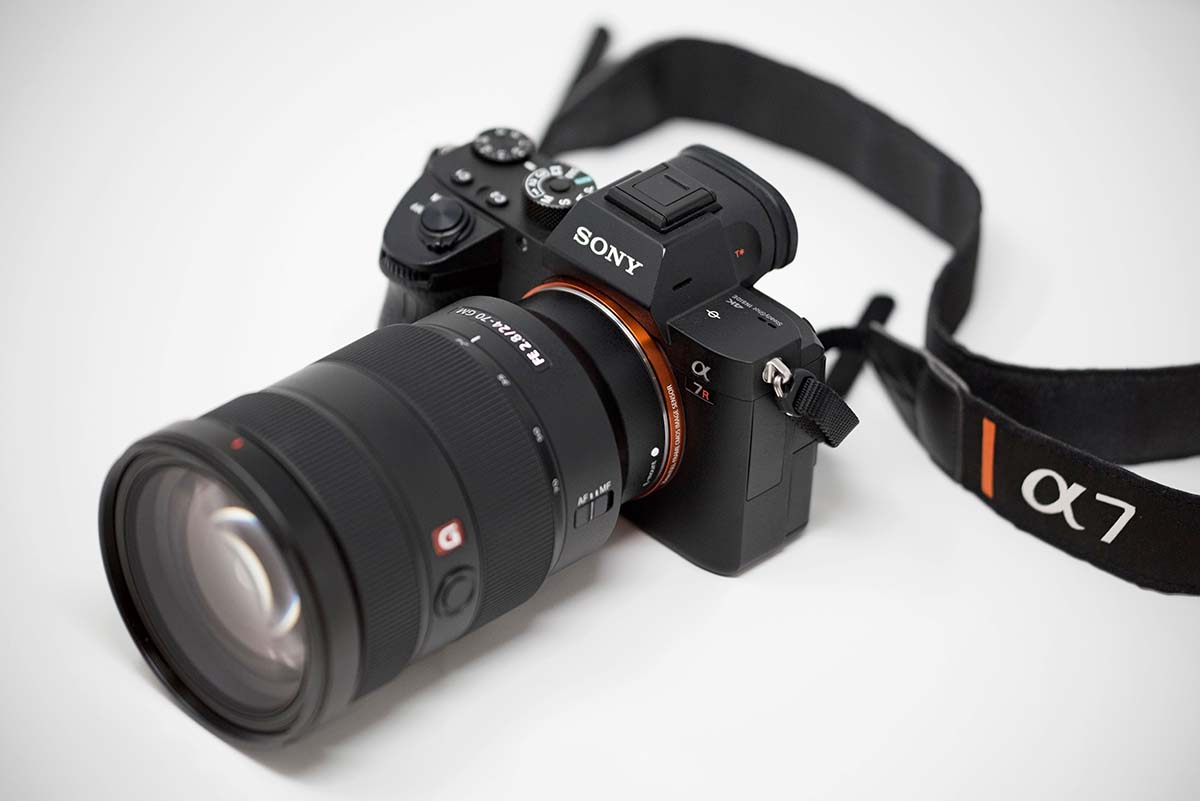
Before mirrorless cameras existed, digital SLRs were the only game in town for professionals and enthusiasts. They still are an excellent option for travel, with large sensors, ample features, and the most varied collection of lenses (digital SLRs have been around longer and therefore have more lenses to choose from). It’s true that DSLRs are bulkier than mirrorless cameras, but not by as much as you might think, and particularly when taking lenses into account. DSLRs are also often slightly cheaper than mirrorless cameras, and especially at the entry-level end of the spectrum. The Canon Rebel T6 at less than $400 with a kit lens is a shining example—you just won’t find that kind of value in mirrorless.
Resolution should be a central factor in your camera buying decision. After all, it’s the quality of the photos and videos that matters most. First, take the size of the image sensor into consideration, which is what will collect all of the information (detail and colors) for your photos. Inexpensive point-and-shoots like the Canon SX620 HS have relatively tiny sensors that measure just 28 sq. mm in size, while premium compacts jump up to 1” (116 sq. mm) sensors. Many DSLRs and mirrorless cameras have APS-C sensors that are approximately 366 sq. mm, depending on the brand. And professionals use full-frame cameras with whopping 864 sq. mm of sensor real estate. After that, the megapixel count influences resolution, although it varies much less than sensor size. For reference, we’ve included both sensor size and megapixels in our product specs and comparison table above.

Before you shop, ask yourself how you plan on using your travel photos. If the majority will be online, any camera on the list will do just fine. If you plan on enlarging or printing your photographs or using them professionally, the size of the image sensor, megapixel count, and your lens choice all play an important role in the quality of the photos. Some of my best photos have been taken with small cameras simply because I had them available, but these are factors to consider. You just can’t replicate a booming photo taken with a DSLR or mirrorless camera and a high quality lens.
A travel camera should be easily portable: you’ll be lugging it with you on flights, in rental cars, and around your neck while walking. Point-and-shoots are the smallest type of camera, and our top budget pick, the Canon PowerShot SX620 HS weighs just 6.4 ounces all-in and will easily slide into most pockets. Mirrorless cameras are larger: they are approximately 2/3 the size of a comparable digital SLR and start at around 12 ounces for the camera body (the Sony Alpha a6000). They won’t quite fit in a pocket but are easy to grip with one hand and have small cases that are light enough to carry with ease. Digital SLRs are the largest type of camera but there are some nice entry-level options like the Nikon D3500 that still weigh well under a pound without a lens. Keep in mind that for both mirrorless cameras and digital SLRs, you’ll need to take into account the bulk and weight of both the camera body and any lenses you will be bringing along.
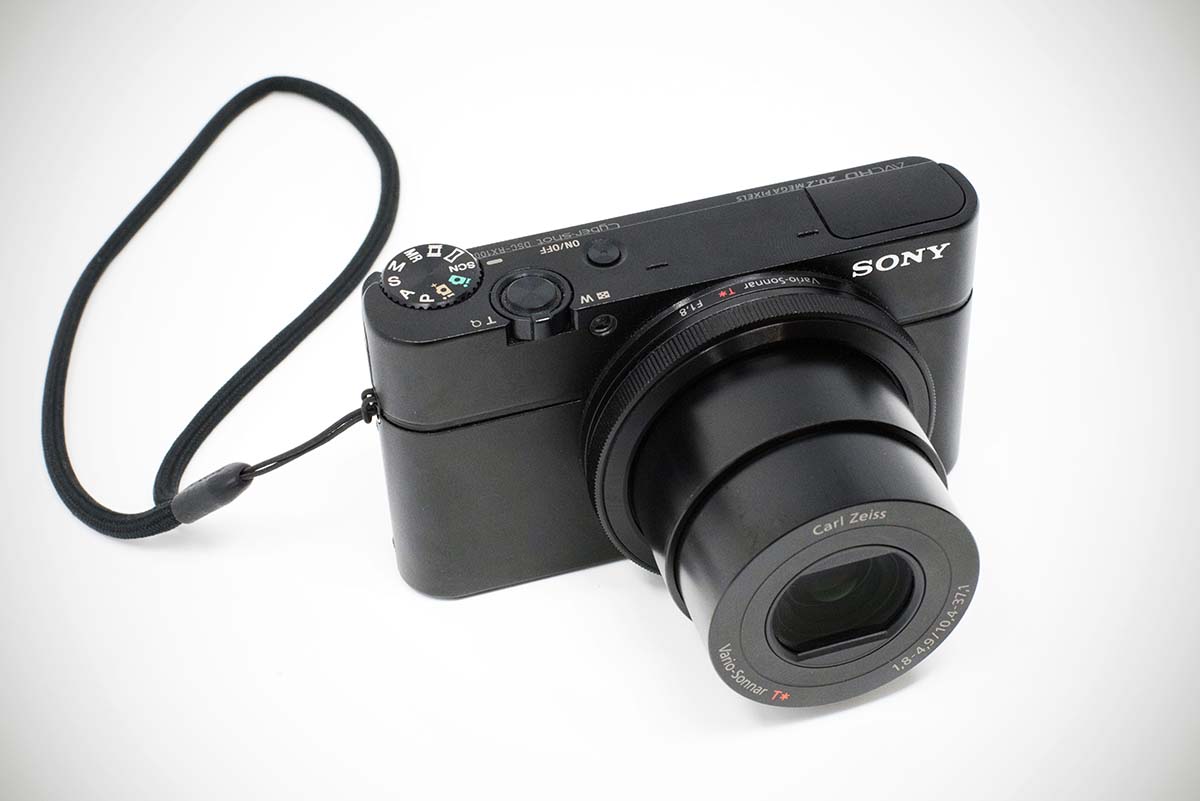
Travel photography involves capturing images in a wide range of circumstances, and sometimes unexpectedly. If you’re buying a point-and-shoot, a camera with a wide zoom range is optimal— the Panasonic ZS200 (24-360mm) wins out over the Canon G7 X Mark II (24-100mm) in this regard. In addition, superzooms have become increasingly popular, which really push the boundaries in terms of zoom range. For example, the Canon SX720 HS has a massive 24-960mm of range while weighing just 9.5 ounces and with a very reasonably $274 price tag. What gives? The image sensor is small and the lens is slow in terms of aperture, both of which are very real trade-offs.
Mirrorless cameras and digital SLRs have interchangeable lenses, and most are offered with a kit lens (an 18-55mm, 16-50mm, or something in that range). It’s worth noting that kit lenses will get you out the door and shooting photos at a good price, but their optical quality generally is limited. If you want better sharpness and bokeh, and lower distortion and vignetting, it’s worth spending up for higher-end zooms or primes (more on that in our travel lenses section below).
The last thing you want when traveling is to be handicapped by fear of carrying or using your camera. In dense urban areas, for example, it can be uncomfortable and somewhat risky to have an expensive camera and bag of lenses knowing that someone else at your crowded café may be eyeing it. When traveling in small villages in impoverished countries, it can feel awkward and attention grabbing to break out a $3,000 full-frame DSLR (you may wish you had a smaller and more unassuming camera). The point is that you want to be able to to use your camera at all times—it doesn’t do you any good in your hotel room or backpack.
Point-and-shoots are most discreet due to their small size—I love that a common thief would likely have no real idea that the Sony RX100 VII or Ricoh GR II s such a nice camera. Mirrorless cameras generally look less expensive than DSLRs but clearly are the real deal. DSLRs look the most expensive due to their size but that doesn’t at all mean you shouldn’t use one—just take proper precautions to keep it safe.
Depending on the type of travel you do, a weather resistant camera may be in order. Generally, we don’t recommend rugged models, which essentially are basic point-and-shoots that have a special casing to make them waterproof, dustproof, shockproof, etc. The truth is that these cameras have small sensors and you pay a lot for the protection. The Olympus Tough TG-6 is one of the leading rugged cameras on the market, but I prefer a cheaper point-and-shoot that offers superior image quality. The exception to this rule would be serious outdoor excursions like rafting or long overland travel to remote places where you just don’t want to think about the condition of your camera.
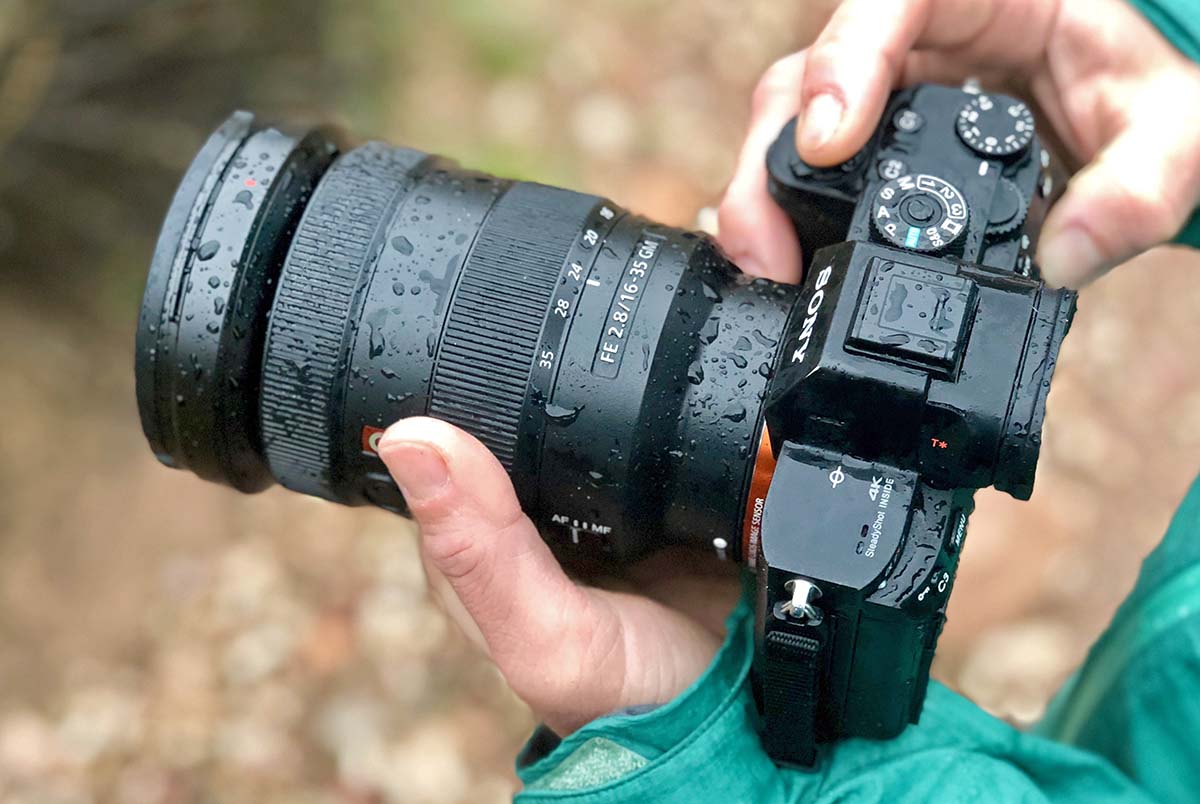
Reasonable care, not shooting in wet or dusty weather, and proper storage will protect most cameras just fine. However, some mid-range and high-end cameras are weather resistant and have sealed joints that make them better able to handle the elements. For more information, see our list of weather-sealed DSLRs and weather-sealed mirrorless cameras.
Video is a take it or leave it feature: some people love it, while others rarely use it and don’t need to pay extra for the functionality. Even pocket cameras capture 1080p video nowadays, but 4K is becoming much more prevalent. When buying a mirrorless camera or DSLR, features like a flip-out LCD screen are designed for shooting video, as are lenses like Canon’s STM collection. Most cameras shoot decent video, but videographers will want to make that a priority in their buying decision.
Once you’ve locked down your camera selection, it’s time to start thinking about travel lenses. Point-and-shoots come with an attached lens so there are no choices to be made there, but mirrorless cameras and digital SLRs have interchangeable lenses and the glass you choose can make a huge difference. Both types of cameras are offered with kit lenses that are 18-55mm, 16-50mm, or something in that range. These are decent starter options that get you out of the door and shooting photos, but are middle-of-the-road in terms of image quality. Many people supplement their lens collection at the outset of their camera purchase or sometime after.
In terms of lens selection for travel, there are two main routes you can go: 1) A versatile zoom lens that covers most of your shots; or 2) A handful or primes that can be switched out depending on your desired focal length. For either, we think of the heart of the travel photography focal length range as 24-70mm. There are great lenses with those exact focal lengths: the 24-70mm f/2.8 is the classic pro zoom, but it’s more readily available for full-frame cameras than APS-C. The good news is that APS-C prime lenses are reasonably price compared to their full-frame counterparts, so it’s not a huge financial burden to pick up a 35mm or 50mm prime to supplement your kit zoom lens.
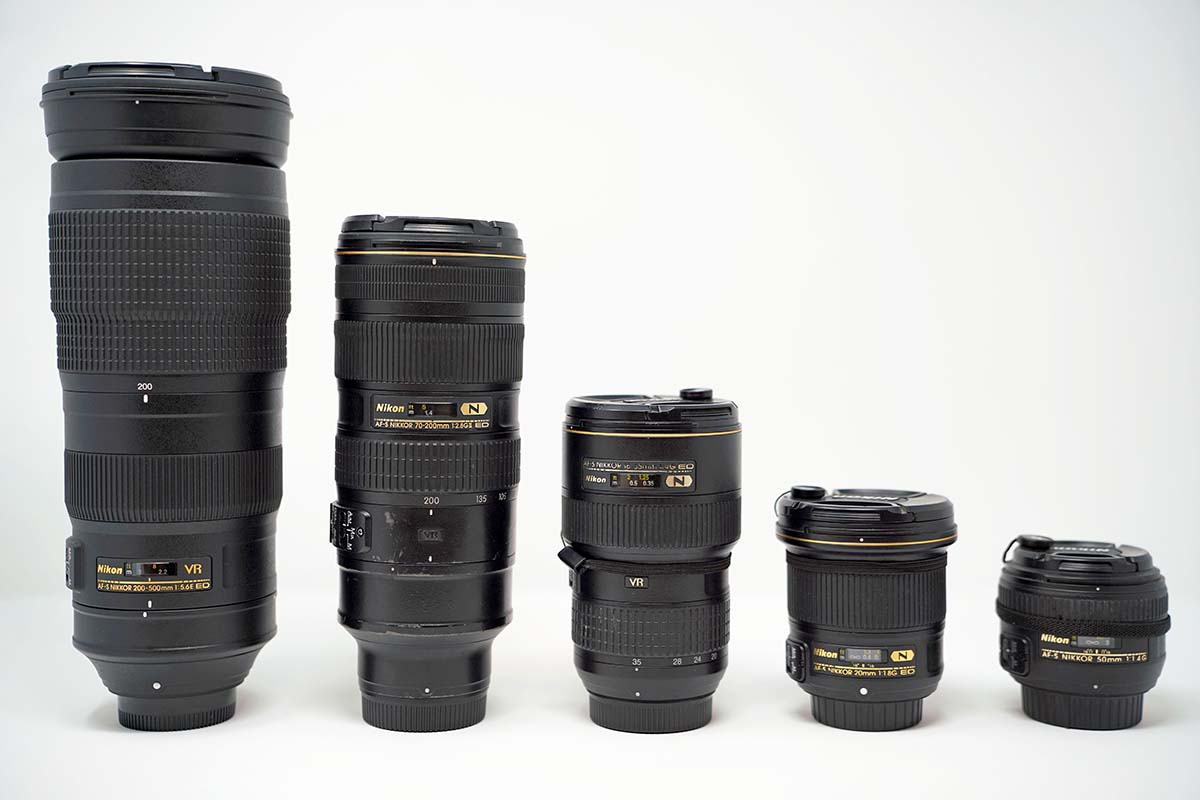
If you are planning on shooting close-ups of faraway objects or wildlife photography, you’ll want to add a telephoto lens to your collection. Again, these are much less expensive for APS-C cameras than full frame. There also are all-in-one options of the 18-200mm and 18-300mm varieties that cover all of the focal lengths mentioned above, but they are heavy and not as good optically as specialty lenses. We’ve shot with all-in-one lenses many times, but feel that primes or zooms with smaller focal length ranges are the best way to go. For more information, see our lens reviews.
Back to Our Top Travel Camera Picks Back to Our Camera Comparison Table